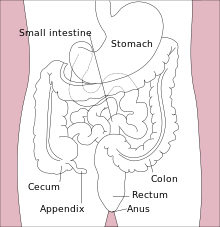| McBurney's point | |
|---|---|
 Location of McBurney's point (1), located two thirds the distance from the umbilicus (2) to the right anterior superior iliac spine (3). Location of McBurney's point (1), located two thirds the distance from the umbilicus (2) to the right anterior superior iliac spine (3). | |
 Surface projections of the organs of the trunk, with McBurney's point labeled with a red circle at bottom left at the inferior part of the cecum. Surface projections of the organs of the trunk, with McBurney's point labeled with a red circle at bottom left at the inferior part of the cecum. | |
| Identifiers | |
| FMA | 11362 |
| Anatomical terminology[edit on Wikidata] | |
McBurney's point is the point over the right side of the abdomen that is one-third of the distance from the anterior superior iliac spine to the umbilicus (navel). This is near the most common location of the appendix.
Location
McBurney's point is located one third of the distance from the right anterior superior iliac spine to the umbilicus (navel). This point roughly corresponds to the most common location of the base of the appendix, where it is attached to the cecum.

Appendicitis
Deep tenderness at McBurney's point, known as McBurney's sign, is a sign of acute appendicitis. The clinical sign of referred pain in the epigastrium when pressure is applied is also known as Aaron's sign. Specific localization of tenderness to McBurney's point indicates that inflammation is no longer limited to the lumen of the bowel (which localizes pain poorly), and is irritating the lining of the peritoneum at the place where the peritoneum comes into contact with the appendix.
Tenderness at McBurney's point suggests the evolution of acute appendicitis to a later stage, and thus, the increased likelihood of rupture. Other abdominal processes can also sometimes cause tenderness at McBurney's point. Thus, this sign is highly useful but neither necessary nor sufficient to make a diagnosis of acute appendicitis. The anatomical position of the appendix is highly variable (for example in retrocaecal appendix, an appendix behind the caecum), which also limits the use of this sign, as many cases of appendicitis do not cause point tenderness at McBurney's point. For most open appendectomies (as opposed to laparoscopic appendectomies), the incision is made at McBurney's point.
Pseudoaneurysm
A pseudoaneurysm in the aorta may be treated surgically, with an incision made between McBurney's point and the lower intercostal spaces.
Peritoneal dialysis
McBurney's point may be a useful site for insertion of a peritoneal dialysis catheter.
History
McBurney's point is named after American surgeon Charles McBurney (1845–1913). McBurney himself did not locate his point in a precise way in his original article.
The seat of greatest pain, determined by the pressure of one finger, has been very exactly between an inch and a half and two inches from the anterior spinous process of the ilium on a straight line drawn from that process to the umbilicus
— Charles McBurney, "Experience with Early Operative Interference in Cases of Disease of the Vermiform Appendix"; New York Medical Journal, 1889, 50: 676–684 .
References
- ^ Fasen, Geoffrey; Schirmer, Bruce; Hedrick, Traci L. (2019-01-01), Yeo, Charles J. (ed.), "Chapter 164 - Appendix", Shackelford's Surgery of the Alimentary Tract, 2 Volume Set (Eighth Edition), Philadelphia: Elsevier, pp. 1951–1958, doi:10.1016/b978-0-323-40232-3.00164-3, ISBN 978-0-323-40232-3, S2CID 239120680, retrieved 2020-12-15
- ^ Noel, Richard J. (2018-01-01), Kliegman, Robert M.; Lye, Patricia S.; Bordini, Brett J.; Toth, Heather (eds.), "12 - Vomiting and Regurgitation", Nelson Pediatric Symptom-Based Diagnosis, Elsevier, pp. 204–234.e1, doi:10.1016/b978-0-323-39956-2.00012-1, ISBN 978-0-323-39956-2, retrieved 2020-12-15
- Kyung Won Chung (2005). Gross Anatomy (Board Review). Hagerstown, MD: Lippincott Williams & Wilkins. pp. 255. ISBN 978-0-7817-5309-8.
- "Definition: McBurney's sign from Online Medical Dictionary". Retrieved 2007-12-06.
- ^ Sifri, Costi D.; Madoff, Lawrence C. (2015-01-01), Bennett, John E.; Dolin, Raphael; Blaser, Martin J. (eds.), "80 - Appendicitis", Mandell, Douglas, and Bennett's Principles and Practice of Infectious Diseases (Eighth Edition), Philadelphia: W.B. Saunders, pp. 982–985.e1, doi:10.1016/b978-1-4557-4801-3.00080-1, ISBN 978-1-4557-4801-3, retrieved 2020-12-15
- ^ Prager, Elliot (2005-01-01), Fazio, Victor W.; Church, James M.; Delaney, Conor P. (eds.), "Acute Appendicitis", Current Therapy in Colon and Rectal Surgery (Second Edition), Philadelphia: Mosby, pp. 259–262, doi:10.1016/b978-1-55664-480-1.50051-4, ISBN 978-1-55664-480-1
- Byrne, John; Darling III, R. Clement (2009-01-01), Evans, Stephen R. T. (ed.), "Chapter 59 - Aortic Surgery", Surgical Pitfalls, Philadelphia: W.B. Saunders, pp. 597–612, doi:10.1016/b978-141602951-9.50075-x, ISBN 978-1-4160-2951-9, retrieved 2020-12-15
- Soni, Sachin S.; Barnela, Shriganesh R.; Saboo, Sonali S.; Takalkar, Unmesh V. (2019-01-01), Ronco, Claudio; Bellomo, Rinaldo; Kellum, John A.; Ricci, Zaccaria (eds.), "Chapter 188 - Nursing and Procedure Issues in Peritoneal Dialysis", Critical Care Nephrology (Third Edition), Philadelphia: Elsevier, pp. 1134–1136.e1, doi:10.1016/b978-0-323-44942-7.00188-6, ISBN 978-0-323-44942-7, S2CID 87745135, retrieved 2020-12-15
Bibliography
- Naraynsingh V, Ramdass MJ, Singh J, Singh-Rampaul R, Maharaj D (2003). "McBurney's point: are we missing it?". Surgical and Radiologic Anatomy. 24 (6): 363–5. doi:10.1007/s00276-002-0069-7. PMID 12652363. S2CID 43595987.
External links
| Human surface anatomy and general regions | |||||
|---|---|---|---|---|---|
| Head | |||||
| Neck |
| ||||
| Thorax | |||||
| Arm | |||||
| Abdomen/pelvis |
| ||||
| Perineal | |||||
| Leg | |||||